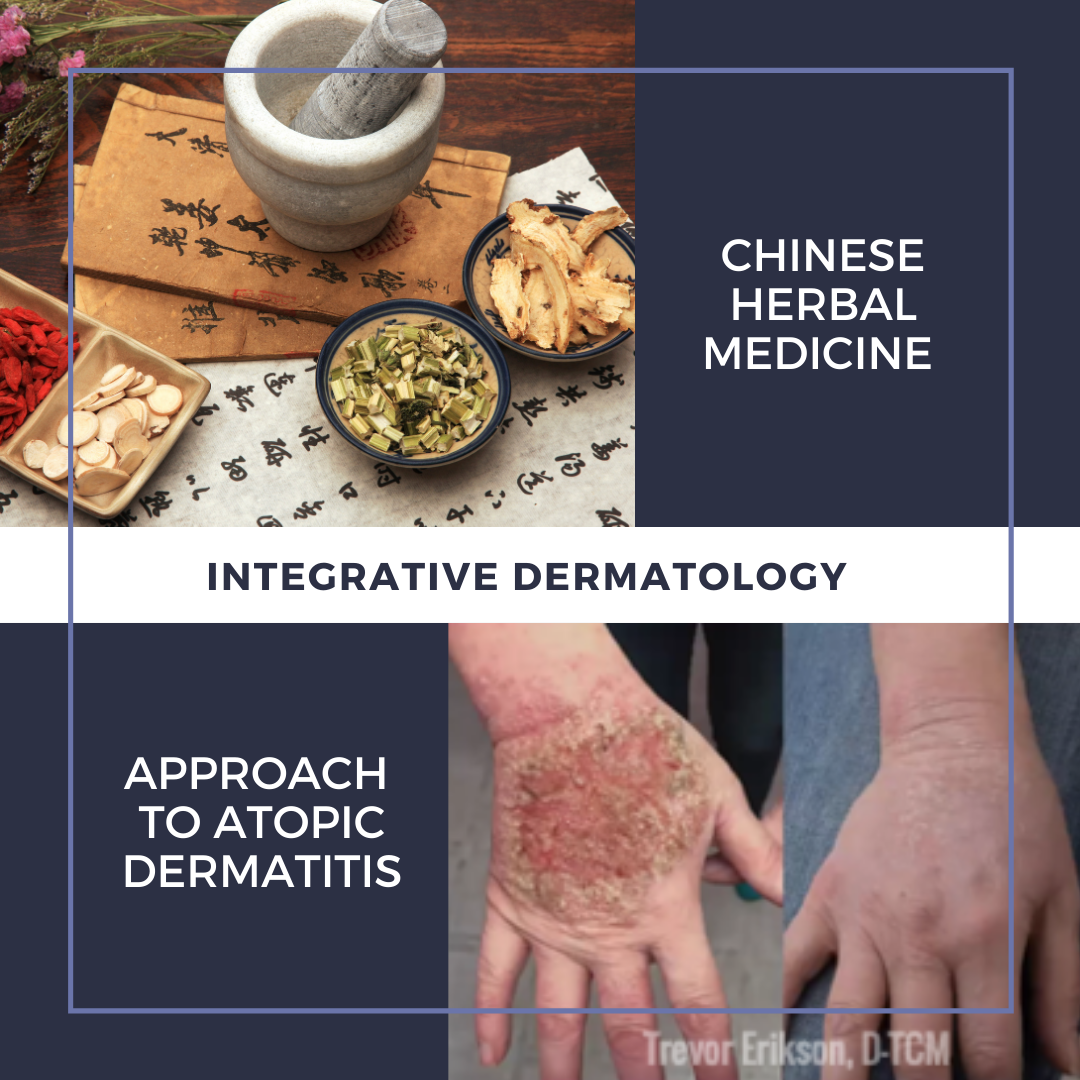We are constantly learning in dermatology. With advents of new techniques, sometimes traditional methods can be forgotten or lost. Chinese Herbal Medicine dates back thousands of years. Just as we shouldn’t retire chemical peels in favor of a “laser-only” approach, maybe we shouldn’t give up on other traditional methods.
During the 2020 Integrative Dermatology Symposium, Dr. Trevor Erikson, D-TCM, shares a primer on the treatment of atopic dermatitis using Chinese herbal medicines. In his presentation, Treatment of Atopic Dermatitis with Chinese Herbal Medicine, he discusses the basics and shares a notable case.
This review will provide an overview of the talk, including:
-
- A brief discussion of the history of Chinese herbal medicine
- Basic nomenclature in the diagnosis of the specific type of atopic dermatitis
- A case review highlighting the benefit that can be found with appropriate herbal treatment
- Brief review of published studies using Chinese herbals in atopic dermatitis treatment
Before we get into the full review, here are my “Ah-ha moments” – what I took away from the lecture that I found intriguing:
-
- We should open our minds to alternative methods, and at least know how to find alternative medicine practitioners for patients who desire this. (Where should you turn? Keep reading!)
- Chinese herbal medicine utilizes phases of treatment – adjusted as the patient characteristics change (What patterns are monitored? See below!)
- Studies do exist! There are a few small studies. Studies in this area are hard to perform as each patient would traditionally receive a specific treatment (What do some studies reveal? Look below!)
A Quick Overview of Traditional Chinese Medicine
Traditional Chinese Medicine (TCM) utilizes herbs in oral, topical, and injectable forms to treat disease (and many other techniques). It utilizes individually composed formulations of many herbs to create a treatment for the specific patient’s morphology and symptomatology. Further information can be found here – https://jamanetwork.com/journals/jamadermatology/article-abstract/189568.
In contrast to western medicine, the patient’s presentation, more than the diagnosis, drives the treatment. As mentioned by Dr. Erikson – “different treatments for identical diseases.” In a similar manner to western medicine, treatment is done in phases. In traditional western medicine, we might provide a topical corticosteroid for the acute phase to be applied daily, then possibly decrease to weekly or involve topical calcineurin inhibitors. However, in TCM, the phases are based on patterns of the patient’s presentation but do involve acute, sub-acute, and chronic phases. Some key terminology with regard to atopic dermatitis are: heat, fire, dryness, stasis, and dampness. These are considered the pathogenic factors in atopic dermatitis. Other systemic findings are also considered such as: digestion, thirst, urination, sleep, and sweat. To simplify, two main patterns were discussed:
1) excessive heat/fire with or without dampness
2) Deficiency patterns: Qi, blood, and Yin.
See below for some example slides about determining the pattern.
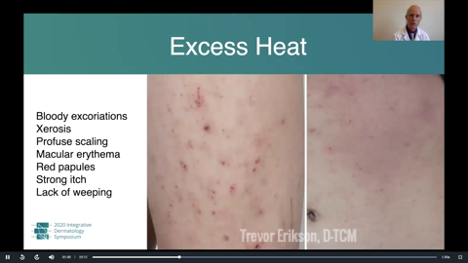
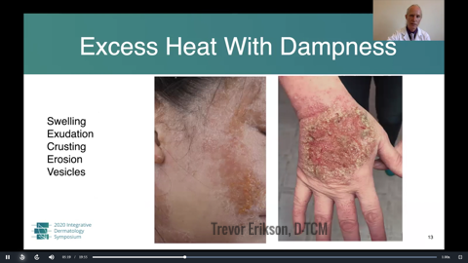
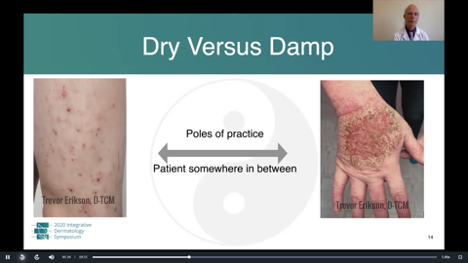
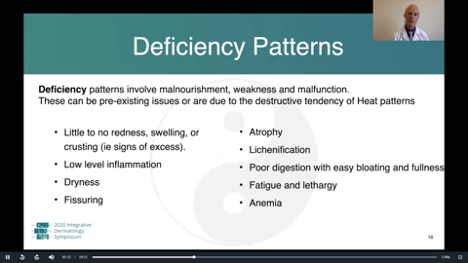
Phase Treatment with TCM
-
- First, we clear the excess – “put the fire out” – suppress the active inflammation
- So first, there is “attacking” treatments to control the flare. Then “supplementation” treatment is initiated to help control the underlying deficiencies and restore skin barrier function
Let’s See a Case
-
- 50-year-old female with history of atopic dermatitis as a child and currently active disease. Also, history of urticaria and asthma. Stopped topical steroids and emollients as these seemed to worsen her disease or not help it. Worse on the backs of the hands. IBS tendency, strong thirst, normal urination, upon waking she feels hot and sweaty. Symptoms of strong burning itch.
- The herbs used by Dr. Erikson are raw-dried ingredients that are cooked into a tea and then imbibed. Dr. Erikson mentions that the flavor can be quite pungent.
- 10-20 different ingredients are chosen individually for each patient based on their pattern.
- As you see below, the majority of the ingredients are targeted to “clearing” the skin and only a small number for supplementing in the beginning. As the patient’s pattern changes or improves, the herbs are changed to meet the acute pattern and supplement for deficiencies. The entire treatment course is truncated here but continues toward the supplementation pole as the patient’s acute status improves. Dr. Erikson mentions that during flares of her disease they will add in “clearing” herbs and then revert back to the maintenance phase of supplementation.

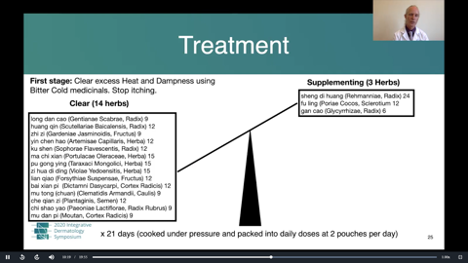
Six weeks later…
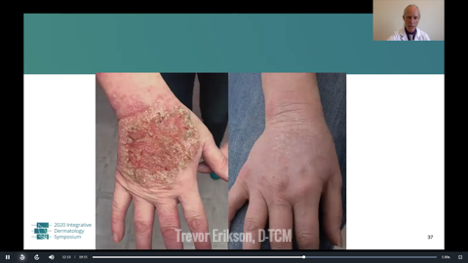
Shifting the prescription toward more supplementation…
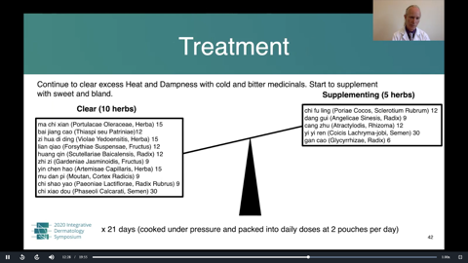
What studies exist?
-
- Studies in this area can be difficult. In practice, each patient may receive 10-20 different herbs that are designed specifically for that patient. This does not lend itself to traditional study designs. Additionally, source, concentration and other factors are hard to control with traditional herbs.
- Two studies were mentioned. One published in the British Journal of Dermatology and one in Lancet – https://pubmed.ncbi.nlm.nih.gov/1536784/ – https://pubmed.ncbi.nlm.nih.gov/1978095/
- Both small studies reported about 70% of patients had a 90% reduction in eczema scores. Zemaphyte was the standard 10 herb decoction used. This is no longer being manufactured.
- Another study comparing oral herbs, versus oral and topical herbs, versus topical steroids and oral placebo was mentioned. Oral herb groups showed improved SCORAD scores compared to topical steroids and oral placebo. https://pubmed.ncbi.nlm.nih.gov/26365443/
Final Thoughts
-
- A few specific herbs were discussed including Ginseng which in studies has shown decreased transepidermal water loss, IgE, improved stratum corneum – however as it is a “hot” herb it should really only be used in the supplementation period and not during flares as this could worsen the skin disease – again this highlights the right treatment at the right time for the patients pattern rather than a “one size fits all” for the disease
- Studies are limited in this space. It would seem prudent to undertake them. While more complex trials could be designed to work with the phases mentioned there are other difficulties to performing randomized trials as noted above.
- Safety of these herbs have limited studies as well. As we know it can be difficult to determine concentrations and components of herbs and therefore safety cannot be assured.
- If your patient is interested in these techniques check out this website for finding recommended practitioners – https://tcmdermatology.org/
- Are you recommending alternative treatments to your patients with atopic dermatitis? If so what types? Have you/they had success?
Please share your comments and join the discussion at the end of this post, and on Instagram @nextstepsinderm!
Dr. Trevor Erikson is a doctor of Traditional Chinese Medicine and a founding board member of the International Traditional Chinese Medicine Dermatology Association (ITCMDA).
The above article was written by Dr. James J. Contestable, Derm In-Review Advisory Council, and represents his interpretation of the information presented by Dr. Erikson during his lecture “Treatment of Atopic Dermatitis with Chinese Herbal Medicine” at the 2020 Integrative Dermatology Symposium.
All images and slides courtesy of Dr. Trevor Erikson, D-TCM
Did you enjoy this article? Find more on Integrative Dermatology here.

